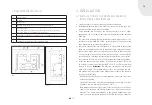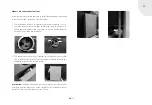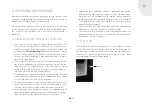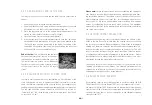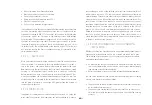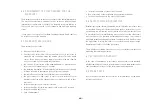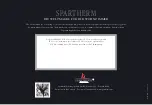
GB
GB
29
• The firebox lining in your fireplace is light and not sooted after burning.
Please note:
The fireplace may not be used as a waste incinerator! Fur-
thermore, the fireplace is only intended for temporary burning. Continuous
operation can also not be achieved due to the extraction of combustion air
and is not permitted.!
5.10 CHIMNEY FIRE
When burning wood (especially softwood), sparks can often be transferred
from the fireplace to the chimney. These sparks can set light to the layer of
soot in the chimney (this only occurs rarely if the chimney has been regu-
larly cleaned by a chimney sweep). The chimney will then burn. This can be
recognised by flames blazing out of the chimney outlet, heavy flying sparks,
smoke and odours or an increasingly hot chimney stack. It is important in
these cases to handle the situation correctly. The fire brigade should be
notified via the relevant emergency number. In addition, a chimney sweep
should be informed about the situation. Combustible objects should be
moved away from the chimney.
Warning from experts:
Do not attempt to put out the fire with water while
waiting. The temperatures in a chimney fire can reach up to 1300 °C. The
extinguishing water will immediately turn to steam. A 10 litre bucket of
water results in 17 m³ of steam. The enormous pressure that results can
break the chimney apart. Once the chimney fire has burnt itself out, the
chimney must be examined by a specialist for cracks or leakages and, if
required, repaired accordingly.
6. CLEANING AND CARE
The fireplace cassette may only be cleaned in a cold state. Please note
that cleaning can lead to soiling of the installation room and your clothing.
We recommend that you protect the area around the opening to the fire-
place from soiling with a plastic sheet or a blanket and that you wear work
clothes. All dismantled components must be installed again after cleaning.
• The fireplace cassette, the firebox, the smoke collection chamber with
the heating gas control system, the combustion air system and the
exhaust flue pipes to the chimney must be inspected for deposits and, if
necessary, cleaned at regular intervals on a yearly basis and also maybe
during and after the heating season and after the chimney has been
cleaned. The deposits should be removed using a hand brush and/or an
ash vacuum cleaner (specialist dealer).The chimney should be cleaned
at regular intervals by a chimney sweep! Furthermore, the fireplace cas-
sette should be inspected each year by a specialist.
• Exhaust gas control system:
Additional exhaust gas deflectors can
be found above the fireplace and in the exhaust gas collection chamber.
These components should be cleaned regularly. The exhaust gas deflec-
tors must be removed in order to complete this task. They need to be
lifted, then twisted and can be removed through the firebox in this way.
The deposits on the deflectors can be cleaned off easily using a hand
brush.
• Ash removal:
Your fireplace cassette is suitable for burning dry wood,
which burns best in its own ash. If you want to remove the ash from the
fireplace, open the fireplace door and remove it e.g. using a dustpan
and brush or with an ash vacuum cleaner. Finally, dispose of the ash in
the correct manner.
• Please note that the embers can still be burning up to 24 hours
later or even longer!
Summary of Contents for L 800
Page 1: ...GB Installation and Operating Instructions Linear Fireplace Cassettes...
Page 34: ...GB 34 NOTES...
Page 35: ...GB GB GB 35...

